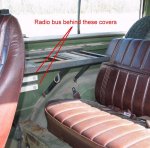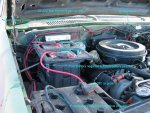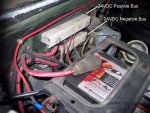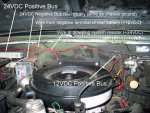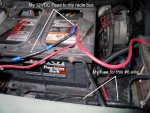All I have back there are two screw holes. I Stuck a volt meter on it and got nothing. Can I activate it some how?
There should be a 24V bus on the passenger side firewall. From there you should have wires running to the passenger compartment (passenger side) under the radio mounting shelf. There are two busses there (positive and negative at 24VDC). (See attached picture)
The positive of the front battery is connected to the negative of the rear battery (series circuit) so that you have 24VDC from the negative of the front battery to the positive of the rear battery.
The negative of the front battery is grounded to the vehicle chassis. So if you read from the positive of the front battery or negative of the rear battery (electrically the same point) you get 12VDC. However if you read from the positive of the rear battery to the vehicle chassis you get 24VDC.
If you mount electrical equipment inside the vehicle that has metal parts that bond to the vehicle chassis then the metal parts of that equipment are at the same potential as the vehicle chassis. Typically this electrical equipment is designed for a negative ground system which means that the negative input lead of the equipment is electrically bonded to the equipment chassis (which electrically bonds to the vehicle chassis).
What does this mean? It means that if you connect the positive input lead of your electrical equipment to the positive of the front battery (or negative of the rear battery) then that equipment sees 12VDC and it is happy. However if you connect the positive input lead of your electrical equipment to the positive of the rear battery and the negative input lead to the negative of the rear battery then that equipment sees 12VDC between its input leads but it sees 24VDC between its positive input lead and its chassis ground. It also means that the positive of the front battery is now shorted to the vehicle chassis ground through your new piece of electrical equipment (think homemade arc welder) and now nobody is happy except the manufacturer of that equipment because now you will be buying a replacement piece of equipment (among other things).
I installed a #6 copper conductor from the negative of the rear battery to the passenger compartment of my M1009 and mounted a third bus under the radio tray. I ran this through a 30A-20KAIC rated fuse and holder (water resistant). This way I can power my commercial radios by connecting between this third bus and the original negative bus (the one electrically bonded to the vehicle chassis). Each radio gets its own inline fuse to protect it and its input wires. (the picture was taken before this third bus was installed)
If one tried to use the rear battery by providing a metal mounting frame isolated from the vehicle chassis by a suitable insulator for a piece of electrical equipment to mount on. Then this metal mount would have to be bonded to the negative of the rear battery so that when the equipment is powered from positive and negative terminals of the rear battery the equipment will see 12VDC and the equipment chassis and negative input lead will be a the same potential so that the equipment does not act like the welding rod of an arc welder. However this is quite dangerous as this isolated metal mount and electrical equipment would be 'hot' with respect to the vehicle chassis (a meter reading from the metal chassis of the equipment to the metal chassis of the vehicle would show 12VDC) and would present some serious shock/arc/fire hazards. So this should never be done!
Technically the original military 24VDC bus and my third 12VDC bus present these same shock/arc/fire hazard but the 'hot' parts are limited to buses that are covered to prevent accidental shorting between them and the vehicle chassis. In the case of a radio or inverter the entire chassis of this equipment would be 'hot' (as well as the mounting frame) and it is harder to cover/protect this from inadvertent grounding to the vehicle chassis.
Your best bet to use the existing military 24VDC buses would be to get a 24VDC input inverter. If you are going 12VDC then stick to the front battery.



